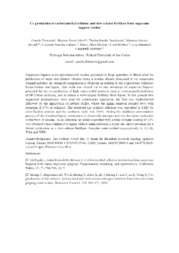Co-production of carboxymethyl cellulose and slow-release fertilizer from sugarcane bagasse residue.
Co-production of carboxymethyl cellulose and slow-release fertilizer from sugarcane bagasse residue.
Author(s): FLORENCIO, C.; SILVA, M. J.; BONDANCIA, T. J.; BRONDI, M. G.; FARINAS, C. S.; MARTINS, M. A.; RIBEIRO, C.; MATTOSO, L. H. C.
Summary: Sugarcane bagasse is an agro-industrial residue generated in large quantities in Brazil after the production of sugar and ethanol. Despite being a residue already processed in the sugar-cane ethanol industry, its chemical composition is abundant in relation to the constituents cellulose, hemicellulose and lignin. This work was carried out to take advantage of sugarcane bagasse potential for the co-production of high value-added products such as carboxymethylcellulose (CMC) from cellulose, and to obtain a slow-release fertilizer from lignin. In this process two sequential pretreatments were used for constituents separation, the first was hydrothermal followed by the application of neutral sulfite, where the lignin removal reached 86% with retention of 87% of cellulose. The extracted and purified cellulose was converted to CMC by etherification process and the synthesis yield was 101%. During the oxidation ammoniation process of the dissolved lignin, ammonium is chemically incorporated into the lignin molecules in the form of amides. As an outcome, an initial coproduct with a total nitrogen loading of 13% was obtained when compared to lignin without ammoxidation, a result that shows potential for a future application as a slow-release fertilizer. Samples were studied comparatively by FT-IR. TGA and XRD
Publication year: 2022
Types of publication: Abstract in annals or event proceedings
Unit: Embrapa Instrumentation
Keywords: Bagasse residue
Observation
Some of Embrapa's publications are published as ePub files. To read them, use or download one of the following free software options to your computer or mobile device. Android: Google Play Books; IOS: iBooks; Windows and Linux: Calibre.
Access other publications
Access the Agricultural Research Database (BDPA) to consult Embrapa's full library collection and records.
Visit Embrapa Bookstore to purchase books and other publications sold by Embrapa.

